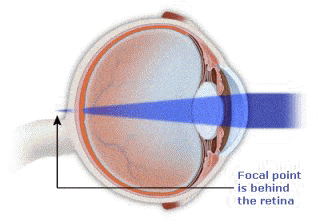Hyperopia, also known as farsightedness or long-sightedness, causes the individual to have difficulty seeing close objects. The eye focuses light behind the retina, instead of directly on the retina, thus causing the blurry near vision. This occurs when an eye is too short. Light rays entering the eye do not come to focus sharply on the retina at the back of the eye. Instead, they focus back behind the eye producing a blurred image. Farsighted individuals, however, can use their focusing muscles to “pull” the image forward onto the retina, often resulting in the ability to see in the distance but lack in ability to see near and intermediate ranges well, as this needs more muscles power. In young persons with high degrees of hyperopia or in individuals over the age of 45, this compensation ability may be inadequate to produce clear images at any range, resulting in blurry vision for distance, near and intermediate ranges.









